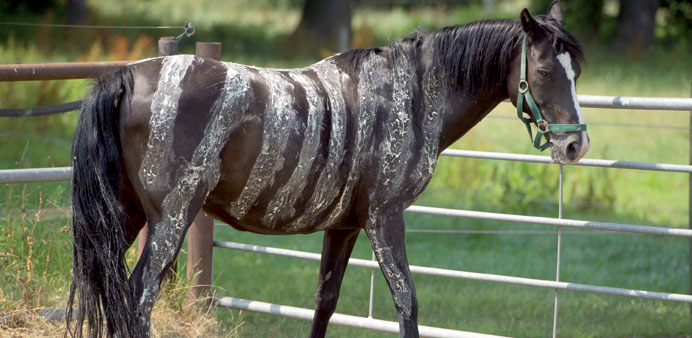A dark horse in a corrall at Uetze in northern Germany wears stripes made of flour and water, an adornment thought to protect the animal from horse-fly stings.
By Heiko Lossie
Scores of horse owners in Germany are turning to a novel method to prevent their animals from being bitten by horseflies: by painting zebra stripes on a horse, they believe it’s possible to ward off the annoying blood-sucking insects.
Social networks in Germany are being flooded with photographs of horses sporting the zebra look. Topics of conversation revolve around which pattern is most effective and what are the best non-toxic paint ingredients. But although some horse owners are convinced the technique works, scientists are not so sure.
Judging by the tone of language used online, it appears there’s no doubt at all that painting a horse with zebra stripes will keep insects away. One site visitor going by the name Sibylle wrote that it’s a sure-fire method. “It’s worked very well. There are a lot less horseflies. They’re swarming above the horse but they don’t land.”
Another user called Lena thinks she came upon the ultimate proof: after painting two-thirds of her horse Cinderella with zebra stripes the paint ran out. As a result horseflies avoided the painted area but continued to attack the bare, unpainted part of the horse.
Advice offered to newcomers at one online forum is the following: “For dark horses I recommend painting white stripes and for light horses my advice is to use dark stripes. The most important thing is that there’s high contrast and the lines are vertical.”
Intense discussions have broken out on the best paint ingredients. Suggestions extend from mixing flour and water (doesn’t last so long) to using professional livestock marker-colours. There are even detailed instructions on how to make a colour applicator to get a horse painted in three minutes.
What sounds like an April fool’s joke is based on scientific evidence. Biologists from Hungary and Sweden discovered about a year ago that zebras need their stripes to provide protection against insects. Before, scientists thought the stripes were a form of camouflage against bigger predators. The theory went that meat-eating animals could not easily see zebras in the shimmering light of the hot savanna or that it made it difficult to make out an individual animal in a stampeding herd.
But an experiment conducted by a team led by Susanne Akesson from Sweden’s University of Lund showed that blood-sucking flies avoided dummies impregnated with attractant if they had stripes.
They also discovered that the slimmer the stripes, the more effective they were. The team wrote in its findings: “We have deduced that zebras developed a hide pattern with narrow stripes so they would be as little attractive as possible for horseflies.”
But the scientists are still trying to work out precisely how the stripes affect insects. Veterinary surgeon Burkhard Bauer, an expert on annoying and blood-sucking insects at Berlin’s Free University has a warning: “It’s a highly complex subject.”
He says there is some evidence that zebras suffer less from insect bites than horses do, but that it might be wrong to put this down to stripes. Bauer says it might just be that they can ward off insects better by twitching their skin. Bauer thinks horse owners who paint their animals with stripes are wasting their time: “Most insects are not interested in stripes.”
He says odour “is the overwhelming attractant” for parasites. But if you are prepared to spend time painting your horse, you are also more likely to believe the effect works. “That’s a well known psychological fact,” says Bauer. — DPA

